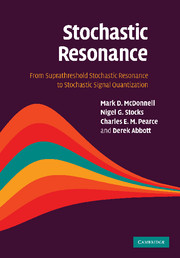Book contents
- Frontmatter
- Contents
- List of figures
- List of tables
- Preface
- Foreword
- Acknowledgments
- 1 Introduction and motivation
- 2 Stochastic resonance: its definition, history, and debates
- 3 Stochastic quantization
- 4 Suprathreshold stochastic resonance: encoding
- 5 Suprathreshold stochastic resonance: large N encoding
- 6 Suprathreshold stochastic resonance: decoding
- 7 Suprathreshold stochastic resonance: large N decoding
- 8 Optimal stochastic quantization
- 9 SSR, neural coding, and performance tradeoffs
- 10 Stochastic resonance in the auditory system
- 11 The future of stochastic resonance and suprathreshold stochastic resonance
- Appendix 1 Suprathreshold stochastic resonance
- Appendix 2 Large N suprathreshold stochastic resonance
- Appendix 3 Suprathreshold stochastic resonance decoding
- References
- List of abbreviations
- Index
- Biographies
6 - Suprathreshold stochastic resonance: decoding
Published online by Cambridge University Press: 23 October 2009
- Frontmatter
- Contents
- List of figures
- List of tables
- Preface
- Foreword
- Acknowledgments
- 1 Introduction and motivation
- 2 Stochastic resonance: its definition, history, and debates
- 3 Stochastic quantization
- 4 Suprathreshold stochastic resonance: encoding
- 5 Suprathreshold stochastic resonance: large N encoding
- 6 Suprathreshold stochastic resonance: decoding
- 7 Suprathreshold stochastic resonance: large N decoding
- 8 Optimal stochastic quantization
- 9 SSR, neural coding, and performance tradeoffs
- 10 Stochastic resonance in the auditory system
- 11 The future of stochastic resonance and suprathreshold stochastic resonance
- Appendix 1 Suprathreshold stochastic resonance
- Appendix 2 Large N suprathreshold stochastic resonance
- Appendix 3 Suprathreshold stochastic resonance decoding
- References
- List of abbreviations
- Index
- Biographies
Summary
The initial research into suprathreshold stochastic resonance described in Chapter 4 considers the viewpoint of information transmission. As discussed briefly in Chapter 4, the suprathreshold stochastic resonance effect can also be modelled as stochastic quantization, and therefore results in nondeterministic lossy compression of a signal. The reason for this is that the effect of independently adding noise to a common signal before thresholding the result a number of times, with the same static threshold value, is equivalent to quantizing a signal with random thresholds. This observation leads naturally to measuring and describing the performance of suprathreshold stochastic resonance with standard quantization theory. In a context where a signal is to be reconstructed from its quantized version, this requires a reproduction value or reproduction point to be assigned to each possible state of a quantized signal. The quantizing operation is often known as the encoding of a signal, and the assignment of reproduction values as the decoding of a signal. This chapter examines various methods for decoding the output of the suprathreshold stochastic resonance model, and evaluates the performance of each technique as the input noise intensity and array size change. As it is the performance criterion most often used in conventional quantization theory, the measure used is the mean square error distortion between the original input signal and the decoded output signal.
Introduction
We begin this chapter by very briefly reviewing the SSR model introduced in Chapter 4. We then introduce the concept of decoding the output of a quantizer's encoding to reconstruct the input signal, and consider measuring the performance of such a reconstruction.
- Type
- Chapter
- Information
- Stochastic ResonanceFrom Suprathreshold Stochastic Resonance to Stochastic Signal Quantization, pp. 167 - 232Publisher: Cambridge University PressPrint publication year: 2008



